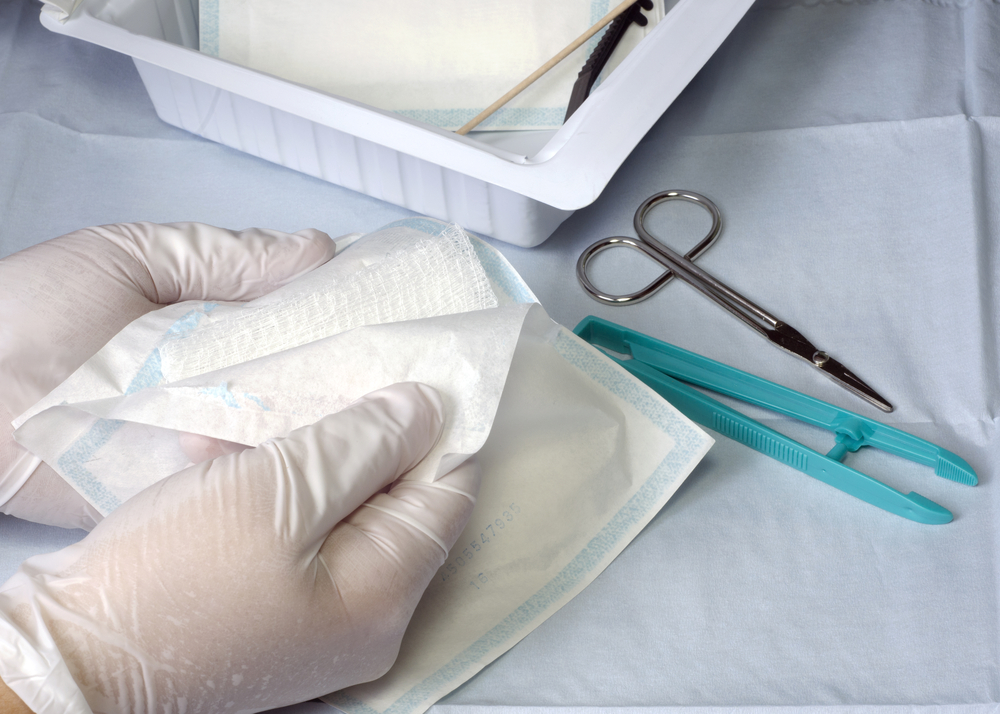Wound care professionals typically use a combination of wound treatment strategies to accelerate tissue recovery and optimize wound healing. A critical strategy for achieving these aims is the use of wound dressings. While there are numerous benefits of using a wound covering during injury resolution, material selection is key to attain the desired clinical response.
What Is a Wound Dressing?
Wound dressings refer to biological, chemical, and physical materials applied over a wound site to aid the healing process. Wound dressings can be used to limit tissue inflammation, prevent microbial overgrowth, prevent tissue infections, and control wound site exudate. Further, some dressings contain materials that stimulate the re-epithelialization phase of wound healing, resulting in a faster recovery rate in treated patients.
Depending on the duration of injury, nature, extent of tissue loss, and presence of complicating factors, wound care experts will have to consider the best wound coverings on an individualized basis. Due to unique physiology, patients will respond differently to wound dressings making it mandatory for their care providers to approach their wound care independently.
Wound Dressings Are Critical to Wound Care
Wound dressings play a crucial role in managing acute to chronic wounds. To begin with, these materials serve as physical barriers between the external environment and the wound, preventing contamination or infection by foreign bodies. Further, some wound dressings contain antibiotic and antifungal agents which help in preventing harmful infections at the injury site.
Also, wound dressing helps to regulate another key determinant of injury resolution: wound exudate/moisture levels. Too little or too much exudate at a wound surface has been shown to slow the rate of wound healing while damaging the surrounding unaffected tissues (periwound). Using the most appropriate wound dressings can reduce the risk of moisture-associated wound damage (MASD) in susceptible patients.
Categories of Wound Dressings
Wound dressings can be sorted into various categories depending on their physical, chemical, and biological properties. The most effective wound dressing materials are outlined below.
- Gauze/cloth dressings
- Transparent dressings
- Collagen dressings
- Foam dressings
- Hydrogel dressings
- Hydrocolloid dressings
- Alginate dressings
Gauze/Cloth Dressings
This is perhaps the most common and readily available type of wound dressing material. This dressing material can be applied in virtually any wound site to cover different tissue injuries such as cuts, scrapes, and bruises. This dressing material can also be used to apply firm pressure over the wound site and absorb excess wound fluids.
Pros:
- Cheap
- Easily accessible dressing material
- Can be applied by anyone with little or no wound care training
Cons:
- Can act as a source of infection if not changed regularly
- Might cause loss of granulation tissue if dressing changes are made too frequently
- Periwound damage is likely when applied by an inexperienced caregiver
Transparent Dressings
Transparent wound dressings are composed of polyurethane material that permits the free flow of oxygen over the wound site and also allows moisture/exudate at the site to evaporate. This helps maintain the right amount of moisture required for optimal healing. Transparent wound dressings are effective in covering the donor sites in tissue graft patients, as well as in those with mild burns and early-stage pressure ulcers.
Pros:
- Reduced friction at the wound site
- Helps in autolytic debridement
- Minimizes bacterial contamination at the wound site
Cons
- Unsuitable for weepy wound with excessive exudate production
- May adhere to wound causing healthy tissue loss and periwound damage on removal
Collagen Dressings
Collagen dressings are particularly beneficial to patients with chronic, slow-healing wounds as they provide an organic scaffold for wound tissue repair. Collagen dressings contain biological materials that encourage the recruitment and proliferation of new cells at the wound site.
Pros:
- Promotes rapid tissue repair by aiding cellular proliferation, new blood vessel growth, and removal of necrotic tissues
Cons:
- Costly wound dressing option
- Requires expert application and follow up
Foam Dressings
For patients with undermined wounds, foam dressings eliminate cavities or pockets formed by tissue destruction. They also provide non-occlusive wound care in patients with burns, chronic venous ulcers, and skin grafts. Foam dressings can also be used in minimizing distressing wound odors and improving patient quality of life.
Pros:
- Optimized patient comfort
- Non-stick dressing material
- Can handle copious wound exudate
Cons:
- Typically requires an additional form of dressing to secure in place
- Wound maceration likely if left in place for too long
- Unsuitable for infected wounds
Hydrogel Dressings
Hydrogel dressings can be used to cover painful, necrotic wounds that have minimal wound exudate. They can also form an effective wound covering in patients with burns or wound site infection.
Pros:
- Handles tender wounds effectively providing soothing relief
- Protects against wound site infection; optimizes the wound healing process
Cons:
- Not suitable for weepy wounds
Hydrocolloid Dressings
These highly absorbent forms of wound dressing can be used to achieve exudate control and optimized wound healing in patients with necrotic injury and chronic ulceration. Hydrocolloid dressings are created from organic materials (e.g., pectin or methylcellulose) that swell and absorb large quantities of moisture.
Pros:
- Highly absorbent dressing type
- Helps in autolytic debridement
- Minimizes bacterial contamination at the wound site
Cons:
- Unsuitable for infected wounds
- Might worse tissue damage in body areas prone to more friction
Alginate Dressings
Alginates represent dressings derived from a special form of brown seaweed. These dressings form a water-loving gel when in the presence of wound moisture allowing its rapid absorption.
Pros:
- Very absorbent dressing material
- Encourages autolytic wound debridement
- Non-adherent
Cons:
- Requires additional wound dressings to be secured in place
- Excessive moisture absorption might lead to wound desiccation



.webp)

.avif)